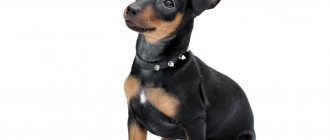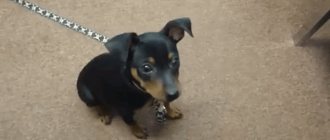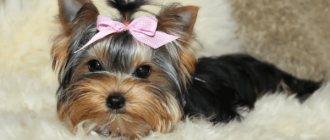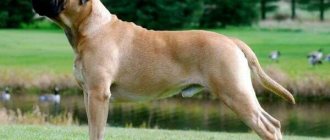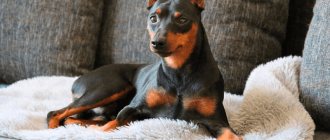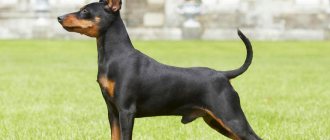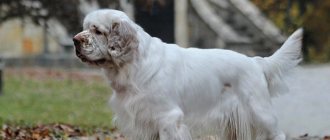There are many unique animals on Earth. Dogs also differ from each other in all sorts of characteristics. Looking at the miniature dog, which seems to be a smaller copy of the standard Doberman, you might think that this is a decorative breed. In fact, the dwarf Doberman is a full-fledged dog that combines many parameters. The basic descriptions of the breed are externally similar to those for which its older brother, the standard-sized Doberman, is famous. In addition to the main name, you can hear that the miniature Doberman is called in a special way. Mini Doberman, miniature or royal pinscher, miniature pinscher - all this belongs to the same breed.
What is the correct name of the breed?
The breed, which is often called the dwarf Doberman and mini Doberman, does not actually exist.
In the standard it is written as a miniature pinscher . But there is still some similarity with Dobermans, and it is explained by the fact that Karl Doberman developed his breed based on miniature pinschers.
Dog and man
Baby miniature is right for you if:
- Do you like walking, cycling or rollerblading;
- Your children are over five years old;
- There are no loopholes in your private home through which a dog can escape;
- You are active and full of energy.
is not suitable for you if:
- You are a homebody;
- You have very young children;
- You have other pets.
Origin story and what it looks like in the photo
The first mentions of miniature pinschers date back to the 15th century . In Germany, in a city called Württemberg, like all cities of the Middle Ages, there was an acute problem with a large number of rats.
At that time, they were actively engaged in breeding a breed that could fight them.
It was on this basis that these dwarf dogs appeared. Also, the miniature pinscher was indispensable for hunting, this allowed him to become an almost universal dog.
The breed gained second popularity in the 20th century, but it has already begun to be adopted as a companion..
Photo of miniature pinscher
In the photo of dwarf pinschers you can see their original appearance and aristocratic inclinations. It is not surprising that this breed is very popular.
Pet character
This is a very capricious breed that requires constant watch and control . This is a very jealous dog. He won't tolerate it if you stop giving him influence.
For the same reason, mini Dobermans are distrustful of strangers, especially if the owner is favorable to them.
Despite the fact that the dog is small, he will without hesitation defend his owner and the rest of the family. At the same time, the dog does not warn about its intentions and will always attack first.
For the same reason, you need to walk your dog on a leash to avoid any unpredictable moments..
Dog socialization should be done as early as possible. A dog that communicates with other relatives grows up calm, balanced and with high intelligence.
Expert opinion
Kozhevin Semyon Kirillovich
Expert dog handler.
“The dog is very self-confident and domineering, if its character is not suppressed, it will sit on the neck and very quickly. She needs someone with the same temperament next to her. She doesn’t like children, so you should always pay close attention to how your pet and your child play. Always attacks without warning and with aggression. But in general, if raised correctly, the dog will never offend without reason. He is always in the best mood towards his owner.”
Advantages and disadvantages of the breed
Before buying a miniature pinscher, it is advisable to familiarize yourself with the advantages and disadvantages of the breed in order to avoid disappointment in the future.
Due to their small size, miniature pinschers can live both in a small apartment and in a huge house without harm to themselves and their owners. The main thing is not to keep them in an enclosure, much less on a chain. Another advantage of being miniature is that there is no need to walk your Miniature Pinscher early in the morning, in very cold or damp weather. An alternative to walking is the litter box, which the dog can easily learn to use.
Miniature Pinschers are very hardy dogs. Overcoming long distances is not a problem for them. They are endowed with good health, hereditary pathologies are practically not diagnosed.
The diet of the miniature pinscher does not require any frills. At the same time, it is necessary to provide the dog with a balanced and high-calorie diet.
The little Doberman has a lively mind and is prone to analyzing a situation and choosing the best solution. This is an easy to train animal that will follow commands just like larger service dogs.
Miniature pinschers have no undercoat and, as a result, visible shedding. This makes cleaning easier, since there will be little wool and hair on the floor.
Also, owners do not have to worry about the presence of a specific smell in the home. To prevent it, a sweaty miniature pinscher is wiped with a damp sanitary napkin and then with a cotton piece of cloth.
The miniature pinscher is capable of protecting an apartment or a small area near the house from the penetration of strangers. Dogs are distinguished by their loyalty, always trying to detect external danger to their owners.
Among the disadvantages, one can highlight the natural cunning of miniature pinschers. They are subordinate to the owner with a “firm hand”. The rest of the household is not an authority for them, the dogs do not listen, I manipulate, and begin to be willful. This makes it difficult for the owner to be absent for a long time, which should be taken into account when purchasing a miniature pinscher.
Small pinschers are characterized by excessive activity (sometimes hyperactivity). They require high physical activity, which neutralizes their inexhaustible energy. In addition, they have a cocky disposition and can start a causeless fight even with a stronger relative. Owners will need to get used to frequent, loud, high-pitched barking, which may not be pleasant to neighbors.
At the genetic level (their ancestors are rat catchers), miniature pinschers have a tendency to dig. Flowerbeds and other plants, including indoor plants, may be affected.
Miniature pinschers are constantly trying to chew something, and can bite if you try to take away something your four-legged friend likes. Therefore, valuable, dangerous items should be kept in inaccessible places.
Miniature pinschers do not take well to prolonged solitude, just like bull terriers. The arriving owner will be unpleasantly surprised by the real pogrom, damaged furniture, chewed shoes, and wires.
Guests should also be wary of the mistrustful little pinscher. They may be left with torn clothing or be bitten. Upbringing affects character.
Breed standard
| Part of the body | Description |
| General form | It is a smaller copy of the German Doberman Pinscher. He does not have all the disadvantages that mini breeds have. This is a graceful, smooth-haired dog whose body resembles a square. |
| Head | The skull is oblong, without an occipital protuberance. The forehead is flat, the transition from it to the muzzle is insignificant. Black nose, black lips adjacent to the jaw. Strong jaws and scissor bite. The eyes are dark and oval. Ears erect or hanging on cartilage. Triangular. |
| Neck | Graceful, smoothly curved, medium length. The base is not marked; it transitions smoothly to the withers. It has no dewlap and dewlap. |
| Frame | The topline is slightly sloping, with the withers forming the highest point of the topline. The back is strong and elastic. The croup is rounded, merging into the base of the tail. The chest is moderately wide, the sternum protrudes. The sides are not quite matched. The tail is not docked. It has a saber or crescent shape. |
| Limbs | The forelimbs are strong and not placed close together. The humerus bones fit tightly to the body. The forearms are straight, strongly developed. The front paws are elastic and strong, the toes are arched, the pads are elastic and black. The hind limbs are slightly set back. The thighs are moderately wide and very muscular. Hock joints with pronounced angles, metatarsus set vertically. The hind legs are slightly longer than the front legs. Fingers are closed, arched. Claws and pads are black. |
| Movements | The breed is a trotter. The back remains strong while moving. The dog moves effortlessly, smoothly and harmoniously with a typical free sweeping trot. |
| Leather | Must fit snugly around the entire body |
| Coat | The coat should be free of bald spots. Short, thick, shiny, also tightly fitting. |
Appearance
A purebred miniature pinscher must meet standards. Disadvantages are indicated by an overly heavy or graceful physique, an elongated, soft or hunchbacked back, short or excessively long legs, and folded skin on the forehead. Defects also include a shortened, pointed, too narrow muzzle, small or large eye size, sparse hair, etc.
General appearance
Miniature Pinschers are exact miniature copies of German Pinschers. They are characterized by an elongated, dry, very muscular body and regular physique.
The forelimbs are slightly shorter than the hind limbs. Each movement of the miniature pinscher is characterized by harmony, confidence, strength, lightness, and smoothness.
Currently, docking of ears and tails in animals, including dwarf Dobermans, is prohibited by law in many European countries. Mini pinschers with cropped ears and tails cannot participate in international exhibitions. The operation is permitted only for medical reasons (necrosis, neoplasms, ulcers).
Wool
The purebred miniature pinscher is a smooth-haired breed with a thick and shiny coat. Bald patches are unacceptable.
Color
According to the requirements of the standard, the dwarf Doberman can be one-color (fawn-red, brownish-reddish, dark red-brown) or lacquered black and tan (tan marks are red or brown). Each mark should have a dark shade and clearly defined outlines. Localization of markings: eye area, lower throat, pasterns, paws, chest (two triangular markings).
American and Canadian cynological organizations recognize miniature pinschers of chocolate, blue, and Isabella and tan colors.
Dimensions
Miniature Pinschers are considered a small breed and do not show any signs of dwarfism. Males and females have the same height at the withers, 24-29 cm. An error of several centimeters is acceptable.
Weight
In accordance with the standard, the weight of an adult can range from 4 to 6 kg.
Advantages and disadvantages
Advantages:
- A small dog that can be kept even in small apartments and rooms, unlike the larger Doberman;
- Very good health, with minimal risk of hereditary defects;
- Very hardy and active, likes long walks;
- Hears well and has an excellent sense of smell;
- It has no undercoat, which means that a person with allergies can get such a dog;
- Short hair hardly sheds;
- There is no specific dog smell;
- They are not friendly in food, but it must be special due to their active lifestyle;
- Will become an excellent guard on its territory;
- They listen to the owner and learn quickly;
- Loyal and faithful to their person;
- They are calm with other pets and children;
- The breed can be litter trained.
Flaws:
- Hyperactivity may develop;
- Desperate bullies who will attack without hesitation;
- They bark loudly and shrilly;
- Very wary of strangers, no matter what relationship the owner has with them;
- They cannot stand loneliness. They take revenge for him by damaging things and furniture;
- They love long and active walks all year round. At least one trip outside per day is necessary;
- His favorite pastime is digging, because in the past dogs were rat catchers;
- During the cold season, you will need clothing;
- They are very cunning, you cannot show weakness around them;
- They love to manipulate the rest of the household.
Description and characteristics
This breed is distinguished by an unusual gait: when running or walking, the dogs raise their front paws high up, which is why the gait is compared to the gait of a horse.
The dog is very energetic and active, and is easy to train. Large families keep her as a pet, but she is also suitable for older people. The main thing is not to spoil your little friend, as the animal quickly gets used to kindness and begins to take advantage of it. The result is an uncontrollable, capricious dog.
Similar article: The main differences between the miniature pinscher and the toy terrier
A mini Doberman will be a great friend for children, but will not allow itself to be offended. He will show aggression towards other dogs and will only be able to get along in character with an animal he has known since puppyhood.
Size, weight and other distinctive features
For females and males, height is 25-30 cm and weight 4-6 kg.
Weight is the main characteristic of the mini Doberman. Due to its excessive activity, the dog can be too thin, and if the diet is chosen incorrectly, it can become obese.
NOTE!
The following are also uncharacteristic of dogs: cowardice, unreasonable aggression, obvious distrust or nervousness.
Also pay attention to height - it should not exceed standard values by more than 2 cm.
Price range
The price of mini Doberman puppies directly depends on numerous factors. On average, when buying an animal you will have to pay from 40 thousand to 100 thousand rubles.* You can find animals cheaper, but then they will no longer be able to take part in exhibitions. As a rule, such puppies are sold secondhand and are much cheaper.
Note! By purchasing a puppy outside of a kennel, no one can guarantee that the animal will be purebred.
Mini Doberman puppies for sale in kennel
Popular colors
The breed standard only recognizes 2 colors for the Miniature Pinscher:
- Black and Tan . Markings should be on the inside of the ears, eyebrows, muzzle, chest, throat, pasterns, paws, on the inside of the hind legs, under the base of the tail.
- Ginger . This is a solid color that covers the dog's entire body.
Previously, there was also a brown and tan color, but today such dogs are bred only in the USA.
Offspring
The popularity of the breed gave rise to many mixed breeds. If you want to buy a purebred Energizer, then contact professional nurseries, where they will provide the pedigrees of the parents. In addition, among Russian aristocrats there are a large number of champions of international European exhibitions.
How to choose a puppy
The breed standard was recently changed for height, reducing the permissible height. Therefore, if you strive for prize medals, then do not chase the big puppies. If the height is 1 cm higher, the skull is apple-shaped, short legs, excessive excitability or aggressiveness, the dog is not allowed into the ring. European judges disqualify docked specimens. Naturalness is encouraged.
Before choosing a strong baby aristocrat, pay attention to the health of the bitch, on which 70% of the viability of miniatures depends. The mother’s nervous system affects the development of the fetus, the amount of milk, and the fullness of lactation.
Therefore, pay attention to the mother's reaction when strangers appear. Excessive aggression is a bad indicator.
Please note that if the puppy’s ears have not “stood up” by the age of 4 months, then you will have to repeatedly apply special bandages-plasters to get protruding ears. But someone may be lucky and the ears will rise on their own at 6 months.
How much does a miniature pinscher cost?
Today, the price of miniature pinscher puppies varies from 10,000 to 30,000 rubles. If the doggies are sold at a lower price, it means they have no pedigree or are out of breeding stock.
Purebred healthy puppies with all the necessary documents, but without obvious exhibition prospects, cost from 10,000 to 20,000 rubles. The offspring of champion parents, for whom breeders predict a brilliant exhibition career, will cost more.
Mating
Breeding mini pinschers involves fewer risks and difficulties compared to Yorkshire terriers and toy terriers. The bitches are healthier, the babies are stronger. If the girl’s dimensions are at the lower limit of the standard, then it will be difficult for her to bear and give birth to offspring. The dog chosen for breeding is not too large, ideally an experienced one.
Although clubs allow mating during the second heat, it is better not to rush and wait for the third
The mother’s bones will have time to strengthen and will not lose the vital calcium depot used for the development of the fetus. The interval between matings is not reduced to a period of less than a year.
The maximum age of the first birth is 4 years, the last - 8-9 years.
Mated on days 8-13 of estrus only in the male's territory. Usually everything goes naturally. The date is repeated every other day, increasing the chances of pregnancy. Pregnancy, as a rule, proceeds without complications. In the first month, mommy is lethargic, barely eats, and is capricious. You can't force feed. It is permissible to pamper with healthy treats and vitamins.
In the second month, the risk of severe obesity in the female increases, which is dangerous for babies. The mother is transferred to food for puppy bitches, but is not overfed. Take him for walks more often, giving him the opportunity to urinate more often.
Before giving birth, the mother's temperature drops to 37.4 degrees, the water breaks and the girl looks for a secluded place. By this time, a box, clean diapers, antiseptics, scissors, and water should be ready for childbirth. If labor is prolonged, call a veterinarian at home.
What diseases are they susceptible to?
Despite their excellent character, there are diseases that can still occur in miniature pinschers:
- Eye diseases (cataracts, glaucoma, entropion, corneal dystrophy);
- Diabetes mellitus and urolithiasis;
- Joint problems (shoulder dislocation, Perthes disease);
- Obesity;
- Pancreatitis.
Do not try to treat your dog yourself, especially with human medicine.
Vaccinations and susceptibility to disease
The first vaccination is carried out at 2 months. The manipulation is carried out by an experienced veterinarian who will monitor the body’s reaction to the administration of the drug. Information about vaccinations is included in the veterinary passport. When the teeth are replaced, the next vaccination is carried out. Before the procedure, 2-3 days, the animal is given an antihelmetic. All other vaccines are administered after the little Doberman turns one year old.
If all conditions of keeping and feeding are observed, pinschers are noted to be in good health. However, there are a number of problems that owners of a small dog may encounter:
- high susceptibility to frostbite and overheating;
- tendency to diabetes;
- possible pathologies of the thyroid gland;
- development of cataracts and glaucoma;
- presence of deafness and epilepsy;
- likelihood of joint dislocation.
Care and maintenance
Caring for a dog is not difficult at all, it will only take a lot of time at first, and then you will get into the rhythm:
- You should walk your dogs at least once a day. The average duration of the walk should be 30 minutes;
- Prefer a harness over a leash. This will make walks more comfortable for the dog;
- Brush your pet 2 times a week. Be careful which comb you choose: it should not injure the animal;
- Mini Dobermans need to be bathed when they get dirty. On average this is 1 time per month;
- Wipe your pet's eyes 1-2 times a week. This can be done with a special lotion or chamomile decoction;
- You need to clean your ears once a week;
- Inspect your pet's teeth, make sure that tartar does not appear. To avoid this disease, brush them 1-2 times a week with a brush and a special paste or give them special treats;
- Trim your claws as they grow;
- After each walk, inspect the paw pads. Make sure there are no wounds, cracks or calluses;
- Vaccinate, worm, and treat fur against fleas and ticks in a timely manner.
Miniature Pinscher Health and Diseases
The Miniature Pinscher has excellent immunity. Even on frosty days you should not refuse a walk. It is enough to wear overalls with a hood. On a rainy day, you need to wear waterproof clothing. This will protect the dog from colds. Vaccinations are also required. The first one is usually done by the breeder. The next visit to the veterinarian should be made at 3 months of age. Subsequent visits are made as prescribed by the doctor.
In addition, it is worth considering that there is a possibility of contracting a disease caused by genetic inheritance. Such diseases include diseases of the eyes, joints, and epilepsy. With proper care and timely consultation with a doctor, these diseases can be easily avoided.
Medicines are usually easily tolerated, but they can be given, including vitamins, only after consultation with a veterinarian.
What is the difference between mini Dobermans and Dobermans
Dobermans and mini Dobermans are very different from each other. Their similarity lies only in appearance - similar color, and miniature pinschers sometimes have their ears cropped.
Otherwise, they are very different: miniature pinschers do not have their tail docked , they are more aggressive, their hunting instinct is better developed, and they are more often disobedient .
And in general, these two breeds have different areas of activity: Dobermans are good at military service and its varieties, and mini-Dobermans are companion dogs and hunter’s assistants.
Nurseries
Purchasing high-quality miniature pinscher puppies is advisable only in nurseries. The babies are accompanied by appropriate documentation indicating vaccinations and other necessary information.
When choosing a miniature pinscher puppy, you should keep in mind that healthy babies are characterized by activity, curiosity and a good appetite.
During the game, you can study the character of miniature pinscher puppies and make your choice. One will behave calmly, the second will show activity, the third will show aggression.
Parents of miniature pinschers should not be left without attention. As a rule, only a healthy dog gives birth to healthy children.
There are a sufficient number of nurseries in Russia where you can choose the miniature pinscher you like most: VANDEBOR (Moscow), Anlit Rilance (St. Petersburg), Pearl of the East (Vladivostok), Irhouse (Arkhangelsk) and others.
Proper feeding
Proper nutrition is very important for this breed. The choice of food depends on the owner, but it must be balanced and healthy.
IMPORTANT!
Up to 4 months, puppies need to be fed 6 times a day, and after this age, gradually reduce the number of feedings so that by the age of one year they are 2 times a day.
Miniature pinschers have very weak digestion, so make a choice - dry or natural food, but do not combine.
The menu should include the following products:
- Meat should always predominate; chicken or turkey is suitable for poultry;
- Fruits should also be given: pear, apple, banana, dried apricots as a treat;
- Boiled egg once a week;
- You can give fish, but only sea fish and no more than once a week;
- By-products can diversify your pet's menu: liver, heart, lung, tongue;
- Give fermented milk products - cottage cheese and low-fat kefir;
- Buckwheat and rice are suitable cereals;
- Miniature pinschers benefit from goat's milk;
- Vegetables should not be excluded either - carrots, cauliflower, broccoli, pumpkin;
- Always make sure the water in the bowl is fresh.
Prohibited foods include: white cabbage, river fish, bones, semolina, baked goods, sweets, smoked foods, sausages, citrus fruits, fatty meat, cow's milk, as well as all food from the human table.
Distinctive character traits of the miniature pinscher
The Miniature Pinscher dog breed is a gentle, affectionate creature that requires proper special care and training. Otherwise, an uncontrollable, dangerous creature will grow up. You should not get this type of dog just to pet it and play. Dwarf Dobermans are created for other purposes. The animal is quite active and will not be able to stay in one place for more than 5 minutes. These creatures have one drawback - they love to bark. Sometimes the barking is so frequent and loud that it begins to seem that there are several animals in the apartment.
One of the characteristic features of the miniature pinscher is excessive suspicion. But these pets calmly accept visitors to the house when they understand that their owner is not a threat. Representatives of this breed are not afraid of large dogs; they bravely rush into battle and do not give up until the fight is over. Strong friendships with other dogs are formed only when they get to know each other at an early age.
Miniature pinschers are reluctant to be held. Raising a domestic dog is not difficult; the Doberman learns quickly and understands everything that is required of him.
How to choose a puppy
First of all, you need to focus on the standard, although this is still difficult to do with puppies.
Ask to look at the parents and their documents, so you can be sure that the puppies really belong to this breed. Choose active, friendly, but not aggressive or cowardly ones.
The dog should not have external defects - lameness, malocclusion, different lengths of limbs . He should look and act like a healthy puppy.
The mucous membranes should be clean, there should be no unpleasant odor from the mouth and ears.
The coat should be free of bald spots, fleas and ticks. The puppy's appetite should be healthy, and the presence of any parasites in the feces is not allowed.
Education and training
Zverg is very stubborn . Education needs to be done from a very early age. Despite their size, puppies often behave like large dogs: they try to attack strangers, show increased curiosity, and try to escape.
The playful nature of training is most suitable for miniature dogs. These are stubborn but sweet creatures who are ready to give in to their owner as soon as they sense him as a leader.
Reproduction and lifespan
The service life of a Pinscher depends entirely on the quality of care for it. If you feed your pet well, treat it on time, and systematically comb and wash it, it will live to be 15-16 years old.
The breeder of Pinschers must be well aware of their exterior in order to be able to distinguish a mongrel from a high-breed representative of the species. A bitch is mated to a male only during her heat, because there the chances of conceiving offspring are higher. This is done on neutral territory.
A female miniature pinscher bears her offspring for 65 to 70 days. There can be 1 puppy or several in a litter. Rarely are more than 5 small pinschers born. It is advisable that a veterinarian be present in the house during the birth of the dog.
Basic rules for keeping dwarf breed dogs
Keeping miniature dogs is not as easy as it might seem at first glance . Sometimes they require much more care than their larger relatives. Owners should adhere to the following rules:
- Handle the animal with care. Do not throw it on the floor and do not allow small, ignorant children to play with it, as there is a high probability of the pet receiving injuries and fractures due to the increased fragility of the bones.
A child can not only accidentally injure a fragile animal, but also feed it unhealthy food.
- Almost all decorative dogs need to be dressed in warm clothes (jackets, overalls, etc.), and in winter they also need shoes.
- Select special hypoallergenic food for small breeds (PRO PLAN Small & Mini Puppy Sensitive Skin, Bosch Mini Adult Lamb & Rice, etc.), which are high in calories (many dwarf breeds are allergic).
- Keep an eye on the coat. Brush, wash and cut regularly.
- Constantly visit the veterinarian (once every six months), since pocket dogs are awarded with a whole bunch of hereditary diseases.
A veterinarian I know told me that very often small, injured dogs are brought to their clinic for appointments, with which the owner’s children have carelessly played. Such games can cost pets their lives.
